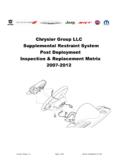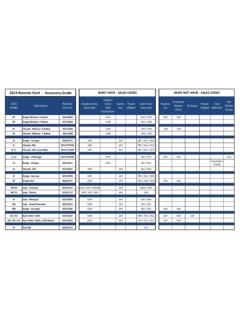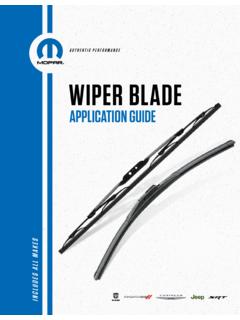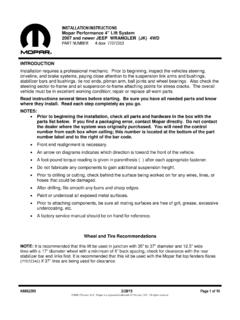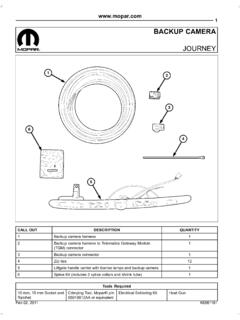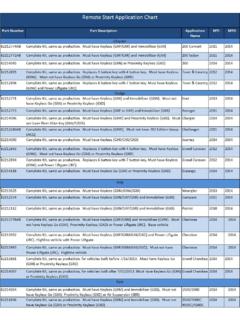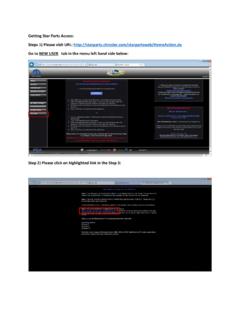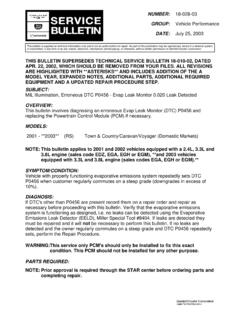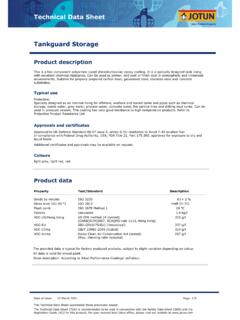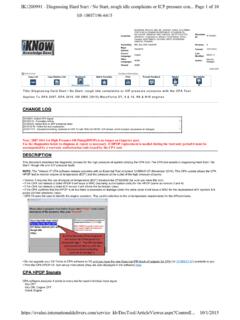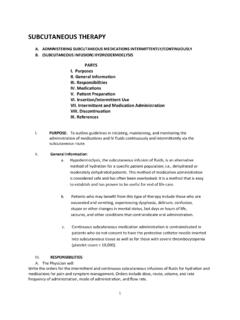Transcription of ELECTRONIC ENGINE CONTROLLER - Chrysler
1 30 / electrical/electronics / 60 Way connectoreProMalternator Field control Driver(underneath heat sink)injector control Driver(underneath heat sink)ignition coil control8 Volt Distributor supply circuitryais Motor DriverMicroprocessorrFi suppressed circuit Boardthe MoPar aDVantageELECTRONIC ENGINE / electrical/electronics / 31 Crankshaft and camshaft sensors: Some aftermarket pickups have not worked properly with Mopar ENGINE controllers. Check for high circuit resistance associated with splices and fusible links; check for open and/or shorted wires. Closed throttle switch operation on AB, AD, AN bodies, 88 91 MY. TBI Dodge Trucks only. Damaged connector terminals: Remove orange gasket from bottom of SMEC/SBEC 60-way connector, reseat connector, and check for symptom/problem.
2 If symptom/problem has been corrected, check 60-way harness and/or connector for terminal damage or loose connection. Wiring harness pin diameter should be .055". Use the male terminals on your PCM as a gauging tool. Excessive current on certain connector pins may damage the SMEC/SBEC. Use of a test lamp or a short in the wiring harness of the vehicle can cause this condition. Always use a DVM when checking the unit/system. Check Technical Service Bulletins applicable to model year and system malfunction. Dirty or carboned throttle bodies are often misdiagnosed as PCM or fuel delivery MoDUle ENGINE controllerModel Year 1988 1989single BoarD ENGINE controllerModel Year 1989 1991 sBecModel Year 1992 1995 sBeciiThe following are often misdiagnosed as defective SMEC/SBEC units: intermittent grounds: Loose or corroded grounds may cause false sensor readings.
3 Auto-shutdown (ASD) relay: Corroded wires or faulty relay. Manifold Absolute pressure (MAP) sensor and Throttle Position Sensor (TPS) voltages: Check voltages over the entire range, not just the extremes. Verify minimum TPS voltage. Minimum air flow: Check for air leaks or airflow obstruction. Automatic Idle Speed (AIS) motor: Shorted windings will set DTSs. Open circuits and intermittent connections will not. Vacuum system: Contaminants or leaks in vacuum lines, notably in line connected to MAP sensor can set MAP pneumatic Fault #13. Fuel pressure and leak down. Vehicle speed sensor operation. Heater voltage for oxygen sensor.
4 Charging system malfunction: Alternator defective or battery not fully charged will set faults. Vehicle Identification Number (VIN) and the vehicle s original mileage must be entered into the PCM to avoid drivability problems and erroneous diagnostic trouble codes. If you are not using a DRB III, please check with your scan tool manufacturer to verify you have the capability to enter this information. Crankshaft and camshaft position sensors: Some aftermarket pickups have not worked properly with Mopar ENGINE controllers. Check for high circuit resistance associated with splices and fusible links; check for open and/or shorted wires. Damaged connector terminals: Visually inspect both 40-way connectors for terminal damage.
5 Excessive current on certain connector pins may damage the SBEC. Use of a test lamp or a short in the wiring harness of the vehicle can cause this condition. Always use a DVM when checking the unit/system. Check Technical Service Bulletins applicable to model year and system malfunction. Dirty or carboned throttle bodies are often misdiagnosed as PCM or fuel delivery problems. Loose timing belts or belts that have jumped a tooth can also be misdiagnosed as PCM or camshaft/crankshaft position sensor Year 1996 2003 sBec iii / iiia / iiiBIMPORTANT!ELECTRONICS TROUBLESHOOTING GUIDEMoPar reManUFactUreD single BoarD ENGINE CONTROLLER (sBec iii)WARNING: Use the DRB scan tool to reprogram the replacement SBEC III (PCM) with the vehicle s original identification number (VIN) and the vehicle s original mileage.
6 Failure to do so may cause idling and/or drivability problems and may set a diagnostic trouble code (DTC).sealed 60 Way connectoreProMalternator Field control Driver(underneath heat sink)injector control Driver(underneath heat sink)ignition coil control8 Volt Distributor supply circuitryais Motor DriverMicroprocessorrFi suppressed circuit Boardthe MoPar aDVantageELECTRONIC ENGINE CONTROLLERNote: The photos shown on this page may not be representative of the actual / electrical/electronics / PoWer anD logic MoDUles Model Year 1984 1987sPark control coMPUtersModel Year 1978 1989 Charging system malfunction: Alternator defective or battery not fully charged.
7 NOTE: SCC does not control charging system in carbureted vehicles. There is an external voltage regulator. Vacuum systems: Contaminants or leaks in vacuum lines, notably in line connected to transducer on SCC. Pin connections: Harness connector pins to SCC or sensors spread apart or corroded, causing open or intermittent connections. Secondary ignition: Aftermarket replacement parts not in specification with OEM. Example: Spark plug wire resistance or wire length. Exhaust system: Catalytic converter malfunctioning or clogged. Magnetic pickups: Check air gap and resistance of pickup(s). Some aftermarket pickups have not worked properly with Mopar ENGINE controllers.
8 Excessive current on certain connector pins may damage the SCC. Use of a test lamp or a short in the wiring harness of the vehicle can cause this condition. Always use a DVM when checking the unit/system. Check Technical Service Bulletins applicable to model year and system malfunctions. Charging system malfunction: Alternator defective or battery not fully charged. NOTE: In 1985 and later vehicles, the voltage regulator is controlled by BOTH the Logic and Power modules. In many vehicles, the voltage regulator is in the alternator. Verify model year of vehicle electronics: Some 1987 P-bodies with turbocharged engines were built with 1986 logic modules.
9 A 1986 logic module can be identified by the MAP sensor mounted on the logic module case, unless TSB #18-03-86 has been performed. Then, the MAP sensor is separate. The 1987 logic modules used MAP sensors mounted in the ENGINE compartment. intermittent grounds: Loose or corroded grounds may cause false sensor readings. Loose or corroded pin connections: Water leakage through kick panel may cause logic module pins to corrode. Manifold Absolute pressure (MAP) and Throttle Position Sensor (TPS) voltages: Check voltage over the entire range, not just the extremes. Verify minimum TPS voltage. Auto-shutdown (ASD) relay operation: Verify distributor connections and proper voltages.
10 Some aftermarket pickups have not worked properly with Mopar ENGINE controllers. Automatic idle speed (AIS) motor: Shorted windings will set DTCs. Open circuits and intermittent connections will not. Vacuum system: Contaminants or leaks in vacuum lines, notably in line connected to MAP sensor. Excessive current on certain connector pins may damage the modules. Use of a test lamp or a short in the wiring harness of the vehicle can cause this condition. Always use a DVM when checking the unit/system. Check Technical Service Bulletins applicable to model year and system following are often misdiagnosed as defective TBI/Turbo Modules:The following are often misdiagnosed as defective SCC:E L E C T R O N I C S T R O U B L E S H O O T I N G G U I D E (CONTINUED)Note: The photos shown on this page may not be representative of the actual / electrical/electronics / 33E L E C T R O N I C S T R O U B L E S H O O T I N G G U I D E (CONTINUED) This program allows the ELECTRONIC transaxle system to recalibrate itself to provide the best possible transaxle operation.
